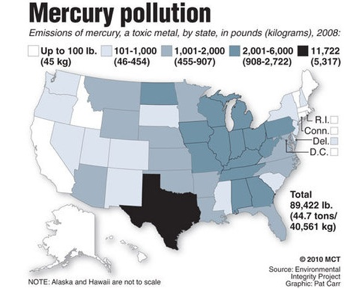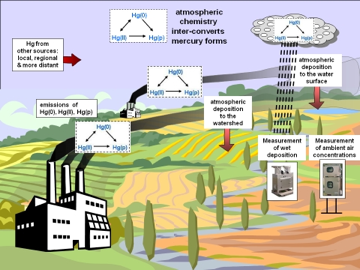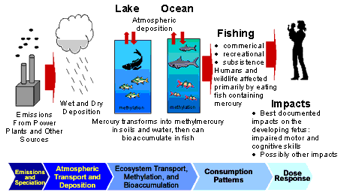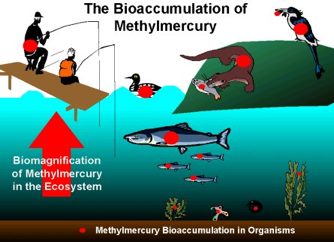


| Fact Sheets | Fish Facts | Fish Consumption Info | About Mercury | Glossary | Presentations | Videos |
Mercury is an element that occurs naturally in the environment. Mercury released into the atmosphere can travel long distances and can end up in freshwater and saltwater ecosystems.
Natural sources of mercury into the atmosphere include volcanoes, forest fires, releases from soil and rocks as they weather (break down over time), and release from the oceans.
Anthropogenic (human) activities have increased the amount of mercury that is released into the environment each year. The amount of mercury released into the atmosphere has increased by a factor of 2 to 4 since the Industrial Revolution.
Coal-fired power plants are the largest source of mercury into the atmosphere. Coal naturally contains mercury, which is released into the atmosphere when the coal is burned. Waste incinerators, cement kilns, mining operations, and pulp and paper milling are other important sources of mercury into the atmosphere.

|
Click on thumbnail to learn about emissions from coal-fired power plants for states and power plants in the U.S. |
Mercury exists in several different forms in the atmosphere:
Elemental mercury (Hg0) is released into the atmosphere as a gas. Elemental mercury can stay in the atmosphere for around one year, so it can travel around the globe before getting transformed into another form. Some elemental mercury can end up far from pollution sources, such as cold polar regions like the Arctic.
Particle bound mercury (Hgp) is mercury released into the atmosphere bound to a particle. The size of the particles will influence how far they can travel. In general, particle bound mercury can stay in the atmosphere for days to weeks and can travel hundreds of miles.
Reactive gaseous mercury (RGM), also called oxidized mercury or ionic mercury, stays in the atmosphere on the order of hours and tends to only travel tens of miles. Reactive gaseous mercury tends to stick in water droplets and then to fall to the ground in precipitation. Elemental mercury gets converted into reactive gaseous mercury before it gets deposited from the atmosphere.
In addition to the form of mercury, other factors influence how far mercury will travel from the source. These factors include: weather, local terrain, and the height at which the mercury is released into the atmosphere.

|
Click on the thumbnail to learn more about how mercury gets into the atmosphere. |
Mercury from the atmosphere eventually ends up on land or in water, either in precipitation (wet deposition) or in particles that settle out of the air (dry deposition). Runoff from the land can carry mercury and other pollutants into streams, rivers, lakes and oceans. Some sources of pollution can release mercury directly into water, such as discharges from industrial sources, wastewater treatment plants, and mining operations.
Once mercury ends up in surface waters, it tends to stick to particles, and much of it ends up in sediments. Low oxygen levels in sediments provide ideal conditions for the growth of sulfate-reducing bacteria, a type of microorganism that can convert inorganic mercury into methylmercury. In general, only a small fraction of mercury in sediments is present as methylmercury. However, methylmercury is a concern because the levels of methylmercury increase in animals higher in the food chain. This process is known as biomagnification.

|
Click on the thumbnail to see how mercury moves through the environment and eventually into animals and people. |
Environment Canada:
About Mercury.
U.S. Environmental Protection Agency:
Mercury.
EPA’s Roadmap for Mercury.
U.S. Geological Survey:
Mercury in the Environment. Fact Sheet 146-00 (October 2000).
Power plants are the largest source of mercury emissions into the atmosphere. This map shows the amount of mercury emissions from power plants for each state in the U.S.

More information about mercury pollution from power plants can be found in a, 2010 report by the Environmental Integrity Project, Dirty Kilowatts America’s Top Fifty Power Plant Mercury Polluters. This report shows the amount of mercury that is released each year from each state, as well as from each individual power plant.
The following table shows the amount of mercury (in pounds) that was released from coal-fired power plants in Oklahoma, Texas, Kansas, Missouri and Arkansas in 2007 and 2008.
Source: Environmental Integrity Project¸ Dirty Kilowatts: America’s Top Fifty Power Plant Mercury Polluters. 2010.
INSERT BIG TABLE HERE
Source: http://www.arl.noaa.gov/images/AirQuality/mercury_cycle50.jpg

Source: http://www.epa.gov/hg/exposure.htm

Please note: sizes of dots are not to scale.
Source: http://www.ec.gc.ca/mercure-mercury/default.asp?lang=En&n=D64997D2-1
There are 6 coal-fired power plants in a 60-mile radius of Grand Lake. A preliminary study by Oklahoma DEQ surveyed mercury levels in top predator fish throughout Oklahoma. In general, mercury levels were highest in fish collected in southeastern Oklahoma. This region is affected by coal-fired power plants in Oklahoma and Texas.

|

|

|
|